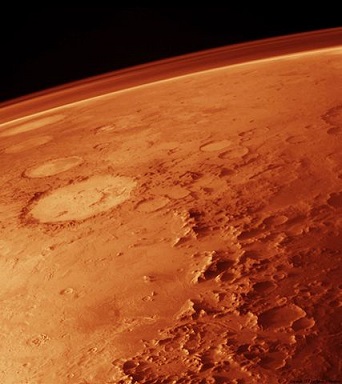Greenhouse effect on other planets: Difference between revisions
J.williams (talk | contribs) No edit summary |
J.williams (talk | contribs) m (1 revision imported) |
(No difference)
| |
Revision as of 21:30, 26 August 2015

The greenhouse effect is not the same on all planets, and differs dramatically based on the thickness and composition of the atmosphere. Three planets that show how dramatically the conditions of a planet can change with the different levels of the greenhouse effect are Venus, Earth, and Mars.
Although Earth, Mars, and Venus are different distances from the Sun, they are not so drastically different that one would expect dramatic temperature differences to occur solely because of this. Since they are a fairly similar distance from the Sun, they formed out of the same material and had approximately the same initial temperatures several billion years ago.[2] Despite these similar initial conditions, Venus is now too hot for life and Mars is too cold. This difference in temperatures is caused partially by the different values for energy incident on these planets. The main difference is still caused by the composition and thickness of a planets atmosphere.
Temperature Difference and the Greenhouse Effect
Looking at Earth's atmosphere, it is mainly nitrogen and oxygen with enough greenhouse gases to raise the Earth's average temperature by 33°C above the -18°C which is the temperature of the Earth without the greenhouse effect]]. This makes the average temperature of the Earth 15°C. The thickness of the Earth's atmosphere, combined with the moderate amount of greenhouse gases works to trap enough radiant heat within the atmosphere to create a temperate, habitable planet.[3]
Mars however, is quite different in its climate than Earth. The main reason for this is that Mars has a very thin atmosphere, with its atmospheric density being only 1% of the density of the Earths atmosphere.[3] As well, the composition causes major differences. Mars' atmosphere is composed mainly of carbon dioxide, but due to the density there is so little carbon dioxide overall that the greenhouse effect is essentially negligible. Because of this, the temperature of Mars is significantly lower than the Earths temperature.
Venus represents the opposite end of the temperature spectrum. The reason for this is that Venus has an atmosphere that is 100x as dense as the Earth's atmosphere, and it is composition contains 96% carbon dioxide. This represents an enormous greenhouse effect that is increasing the temperature of Venus to approximately 462°C - hot enough to melt lead.[3] Although the presence of a runaway greenhouse effect on Venus is part of the reason it is so hot, its proximity to the Sun is also a contributing factor. Surprisingly, the greenhouse effect on Venus is so strong that Venus would be almost twice as cold if Venus had no atmosphere at all, unlike on Earth where the greenhouse effect warms the planet to habitable temperatures.[2]
Overall Earth, Mars, and Venus have similar atmospheres, interiors, surfaces, and similar greenhouse gases in the atmosphere. However, the different levels of greenhouse gases in the atmosphere change the temperatures of the planets quite significantly. Carbon dioxide dominates the greenhouse gases in the atmospheres of these planets, but the warming on the planets varies significantly.[4]
References
- ↑ "Mars atmosphere". Transferred from de.wikipedia to Commons. Original source: taken from Viking Orbiter Raw Image Archive on CD-ROM (PDS) (info;order). Licensed under Public Domain via Wikimedia Commons - https://commons.wikimedia.org/wiki/File:Mars_atmosphere.jpg#/media/File:Mars_atmosphere.jpg
- ↑ 2.0 2.1 Nick Strobel. (May 7, 2015). Planetary Science [Online]. Available: http://www.astronomynotes.com/solarsys/s9.htm
- ↑ 3.0 3.1 3.2 R. Wolfson. (May 7, 2015). Environment and Climate, 2nd ed. New York, U.S.A. Norton, 2012, pp. 335-337
- ↑ Eddie Schwieterman. (May 7, 2015). Comparing the Greenhouse Effect on Earth, Mars, Venus, and Titan: Present Day and through Time [Online]. Available: http://www.astro.washington.edu/users/eschwiet/essays/greenhouse_ASTR555.pdf

